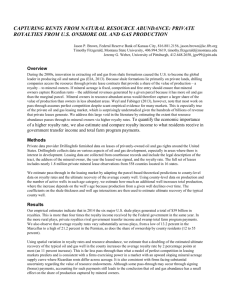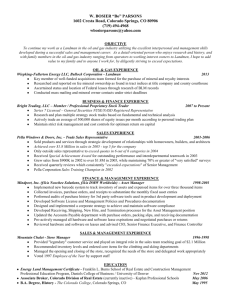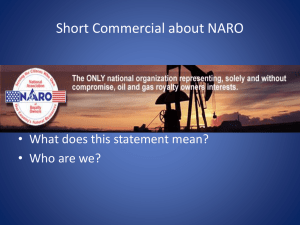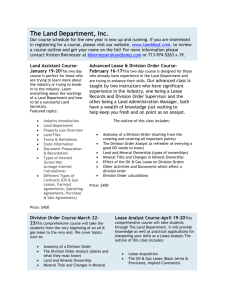Mineral Lease Royalty Rates
advertisement
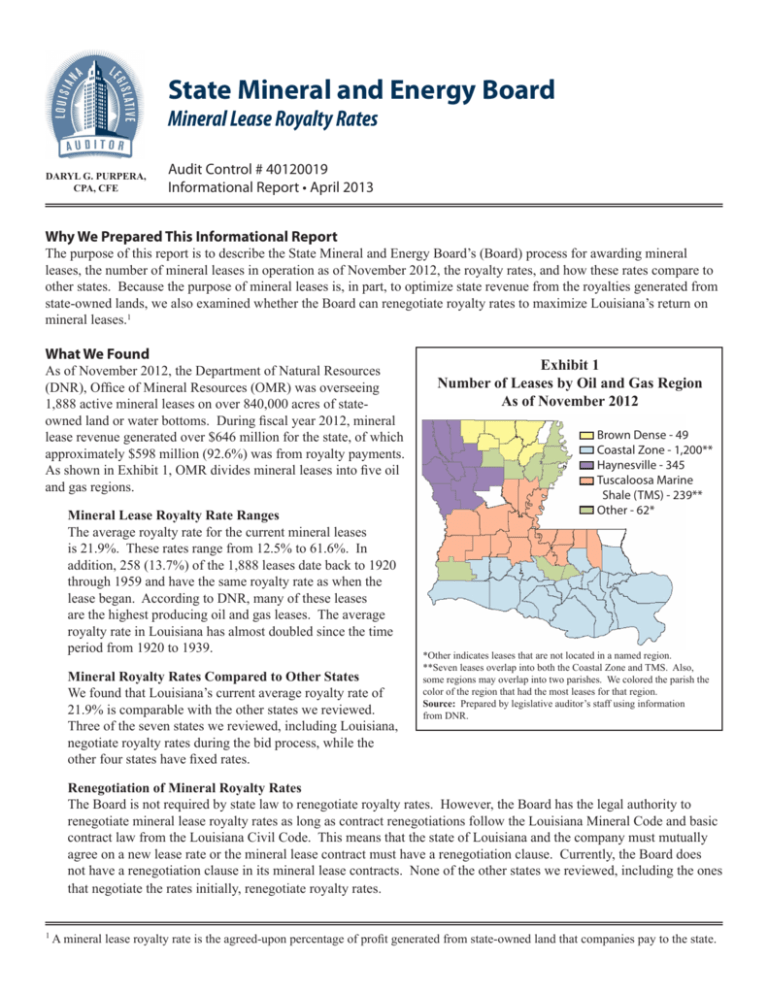
State Mineral and Energy Board Mineral Lease Royalty Rates DARYL G. PURPERA, CPA, CFE Audit Control # 40120019 Informational Report • April 2013 Why We Prepared This Informational Report The purpose of this report is to describe the State Mineral and Energy Board’s (Board) process for awarding mineral leases, the number of mineral leases in operation as of November 2012, the royalty rates, and how these rates compare to other states. Because the purpose of mineral leases is, in part, to optimize state revenue from the royalties generated from state-owned lands, we also examined whether the Board can renegotiate royalty rates to maximize Louisiana’s return on mineral leases.1 What We Found As of November 2012, the Department of Natural Resources (DNR), Office of Mineral Resources (OMR) was overseeing 1,888 active mineral leases on over 840,000 acres of stateowned land or water bottoms. During fiscal year 2012, mineral lease revenue generated over $646 million for the state, of which approximately $598 million (92.6%) was from royalty payments. As shown in Exhibit 1, OMR divides mineral leases into five oil and gas regions. Mineral Lease Royalty Rate Ranges The average royalty rate for the current mineral leases is 21.9%. These rates range from 12.5% to 61.6%. In addition, 258 (13.7%) of the 1,888 leases date back to 1920 through 1959 and have the same royalty rate as when the lease began. According to DNR, many of these leases are the highest producing oil and gas leases. The average royalty rate in Louisiana has almost doubled since the time period from 1920 to 1939. Mineral Royalty Rates Compared to Other States We found that Louisiana’s current average royalty rate of 21.9% is comparable with the other states we reviewed. Three of the seven states we reviewed, including Louisiana, negotiate royalty rates during the bid process, while the other four states have fixed rates. Exhibit 1 Number of Leases by Oil and Gas Region As of November 2012 Brown Dense - 49 Coastal Zone - 1,200** Haynesville - 345 Tuscaloosa Marine Shale (TMS) - 239** Other - 62* *Other indicates leases that are not located in a named region. **Seven leases overlap into both the Coastal Zone and TMS. Also, some regions may overlap into two parishes. We colored the parish the color of the region that had the most leases for that region. Source: Prepared by legislative auditor’s staff using information from DNR. Renegotiation of Mineral Royalty Rates The Board is not required by state law to renegotiate royalty rates. However, the Board has the legal authority to renegotiate mineral lease royalty rates as long as contract renegotiations follow the Louisiana Mineral Code and basic contract law from the Louisiana Civil Code. This means that the state of Louisiana and the company must mutually agree on a new lease rate or the mineral lease contract must have a renegotiation clause. Currently, the Board does not have a renegotiation clause in its mineral lease contracts. None of the other states we reviewed, including the ones that negotiate the rates initially, renegotiate royalty rates. 1 A mineral lease royalty rate is the agreed-upon percentage of profit generated from state-owned land that companies pay to the state. State Mineral and Energy Board What is the Board’s process for awarding mineral leases? OMR serves as the staff to the Board throughout the mineral lease process. Once a month, the Board meets to select which bids should be accepted for mineral leases on state-owned property. These bids include the royalty rate bid for the property. Exhibit 2 summarizes the mineral lease process. Exhibit 2 Mineral Lease Process Step 1 aPotential lease customers request that particular stateowned tracts2 (land or water bottom) be nominated for lease. Step 2 aOMR either accepts or rejects the nominated tract for bid and advertises the property for not more than 60 days prior to the date for the public opening of the bids. Step 3 aInterested parties submit sealed bids on the entirety or a portion of the state tract advertised to OMR by a set deadline. Step 4 aBids are publicly opened and read at the time and date advertised during the Board meeting. Step 5 aOMR staff makes recommendations to the Board regarding which bids should be accepted and which bids should be rejected. The mineral lease royalty rate within the bid is evaluated by looking at historical rates and recent production in that area. As a result, the royalty rates are region-specific. Step 6 aThe Board announces its award decisions during the meeting. Source: Prepared by legislative auditor’s staff using OMR’s leasing manual. Once a mineral lease is signed, the awarded party has 3-5 years, depending on the contract requirements, to start producing on that piece of property. At that time, the awarded party will start paying mineral royalties to DNR for that lease. Until the property has started producing, the awarded party pays a rental fee, specified by the contract, to DNR. If the property has not started producing within 3-5 years, the lease terminates pursuant to its terms. In addition, the lease may terminate if the property stops producing for 60-90 days (in most cases), depending on the contract requirements, after production has started. According to the contract terms, the lease may not be terminated for reasons such as the awarded party paying an in-lieu royalty payment or a force majeure event occurring.3 A tract is an area of land or water. 3 A force majeure event is when oil or gas cannot be produced due to causes outside of control of the awarded party, such as a natural disaster. 2 Page 2 • Louisiana Legislative Auditor What are the royalty rate ranges for the current mineral leases? As of November 2012, DNR was overseeing 1,888 active mineral leases. The oldest active lease dates back to 1920 and has the same royalty rate of 12.5% as when the lease began. The current average royalty rate in Louisiana is 21.9%. The average royalty rate has almost doubled since the time period from 1920 to 1939. Exhibit 3 summarizes the average royalty rates since 1920. Exhibit 3 Mineral Leases, Average Royalty Rates Calendar Years 1920-2012* Time Period Average Rate Number of Leases 1920-1939 1940-1959 1960-1979 1980-1999 2000-2012 1920-2012 13.0% 14.6% 20.5% 23.2% 23.3% 21.9% 35 223 125 278 1,227 1,888 *The royalty rates for 2012 and number of leases were as of November 2012. Source: Prepared by legislative auditor’s staff using information obtained from the mineral lease contracts. Royalty Rates by Region OMR divides mineral leases into five oil and gas regions. Exhibit 4 shows the number of mineral leases, the mineral royalty rate range, and average rate for each region. Exhibit 4 Royalty Rates by Region, Fiscal Year 2012 Region No. of Leases Royalty Rate Range Average Rate Brown Dense 49 12.5%-27.5% 19.6% Coastal Zone 1,200 12.5-53% 21.4% Haynesville 345 12.5%-60% 23.6% TMS 239 12.5%-61.6% 22.4% Other 62 12.5%-30% 22.2% Total 1,888* 12.5%-61.6% 21.9% *Seven leases overlap into both Coastal Zone and TMS. Source: Prepared by legislative auditor’s staff using information from DNR. Mineral Lease Royalty Rates How do Louisiana mineral royalty rates compare to other states? Louisiana’s current average royalty rate of 21.9% is comparable with other states we reviewed. Louisiana ranks sixth highest out of the 32 states that have crude oil production and fifth highest out of the 33 states that have natural gas production.4 For our comparison of other states, we selected five states and the wells in federal waters (federal offshore) based on their proximity to Louisiana and those that are the highest oil and gas producers according to rankings from the Independent Petroleum Association of America.5 Louisiana’s mineral lease royalty rates are negotiated during the mineral leasing process, in contrast to other states like Texas, Oklahoma, and Wyoming that have fixed rates.6 Exhibit 5 Mineral Royalty Rate Comparison As of November 2012 State Texas** Arkansas Louisiana Mississippi** Oklahoma** Wyoming Federal Offshore*** Current No. of Leases Average Royalty Rate* Type of Rate 9,000 140 1,888 20 5,000 4,267 25% 25% 21.9% 20% 18.8% 16.7% Fixed Negotiated Negotiated Negotiated Fixed Fixed 6,723 16.7% Fixed *The average royalty rates listed for the other states (not including Louisiana) do not take into consideration different factors, such as tax rates. **According to these states, the current number of leases is an approximate total. ***Federal offshore refers to all wells in federal waters. Source: Prepared by legislative auditor’s staff using information from other states, the Bureau of Ocean Energy Management, and the U.S. Department of Interior’s Office of Natural Resources Revenue. Can the Board renegotiate mineral leases to increase royalty rates? The Board is not required by state law to renegotiate royalty rates. However, the Board has the legal authority to renegotiate royalty rates as long as contract renegotiations follow the Louisiana Mineral Code and basic contract law from the Louisiana Civil Code. This means that both parties must mutually agree on a new lease rate or the mineral lease contract must have a renegotiation clause. A renegotiation clause would allow the Board to review the contract after a period of time for market trends and to determine if adjustments are needed. Currently, DNR must adhere to the agreed-upon rate for the duration of the lease. As stated previously, the purpose of mineral leases is, in part, to optimize state revenue from the royalties generated from state-owned lands. According to DNR management, the Board does not renegotiate the rates for the following reasons: 1. Companies would not be motivated to accept a higher royalty rate term without the state offering an incentive in return. For example, a company may be willing to offer a higher royalty, but in return it will likely demand concessions from the state, such as an extended period to begin production. 2. Based on discussion with attorneys from the Attorney General’s office, the Board would potentially have to put the tract of land or water through the mineral lease process again, creating the potential that the rate may decrease for that lease. In addition, none of the other states we reviewed renegotiate royalty rates, including the ones that negotiate the rates initially. Renegotiating royalty rates could potentially increase the revenue the state is receiving from oil and gas leases. For example, we reviewed seven of the 258 leases from 1920 to 1959 in Exhibit 3 that have royalty rates less than the 23.3% average rate from 2000 to 2012.7 If the royalty rates for these leases had equaled 23.3% over the last 12 years based on the amount of oil and gas they produced during fiscal year 2012, the state could have collected an additional $2,644,908 in royalty payments. However, the actual economic impact would depend on the criteria DNR used to select the leases to renegotiate and the actual production and royalty rate of those leases. In addition, if the Board started renegotiating royalty rates, there could be instances where businesses would attempt to renegotiate their leases to obtain lower royalty rates, therefore decreasing state revenue. 4 These rankings are from 2010-2011 and were published by the Independent Petroleum Association of America. Our comparison was limited to those states who responded to our inquiry. 6 Louisiana’s bid process allows interested parties to offer their own royalty rates, whereas other states set specific royalty rates before accepting bids. 7 These seven leases are not the only leases with royalty rates less than 23.32% during this time period. 5 April 2013 • Page 3 This document is available on the Legislative Auditor’s website at www.lla.la.gov. This document is produced by the Legislative Auditor, State of Louisiana, Post Office Box 94397, Baton Rouge, Louisiana, 70804-9397. Six copies of this public document were produced at an approximate cost of $1.50. This material was produced in accordance with the standards for state agencies established pursuant to R.S. 43:31.


